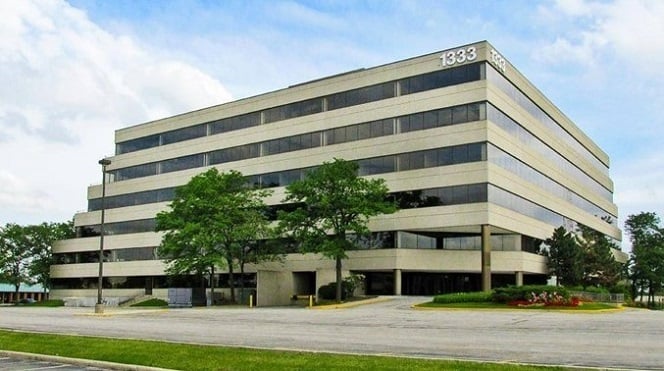
TORONTO—To consider how pervasive distributed networks have become in the world surrounding and intersecting with the commercial real estate sector consider these examples: e-commerce, fintech, co-working, big data, autonomous vehicles and blockchain technologies. All are distributed-network systems “that logistically change where and how work gets done,” says Amy Erixon, Avison Young principal and managing director, investments. “These technologies, plus artificial intelligence, are the most important sea changes affecting investment and operational real estate decision-making today.”
Erixon has prepared a white paper on this all-encompassing subject, titled “Architecture of the Fourth Industrial Revolution—Distributed Networks and Artificial Intelligence, Impacts and Opportunities for the Real Estate Sector.” Yet while the scale and scope of this architecture, combined with the speed at which it's evolving, may appear daunting, one of Erixon's objectives in the new white paper was demystifying the technology, along with reducing the “fear factor” of contemplating the brave new world.
Consider, for instance, that computer technology and robotics have existed in the business world since the 1950s. “These technologies have been with us a long time, and they've been gradually working their way into the workplace,” Erixon tells GlobeSt.com. And while the power of distributed networks and the level of computing power now possible with AI represent technological evolution at a faster pace, “we know more than we think about the evolution of e-commerce and the evolution of fintech.”
She also sought to drill down into the predictive attributes of technology adoption, “because it's not going to happen as rapidly as people believe”—unless, as with public acceptance of smartphones, it occurs more rapidly than anyone expects. “There are patterns that people like Gartner Inc. have studied to inform businesses how urgently they need to think about making these investments and think about these outcomes, by giving them the benefit of expert advice about what these patterns look like.”
In the realm of commercial real estate, Erixon says, “We have an enormous standing inventory. And there's so much that can be done to that standing inventory. There are all these advances in terms of operating economies. There's also a lot of experimentation going on in terms of capital formation strategies.
“Right now we're seeing a lot of need on the part of companies for flexibility in their lease structures, but I don't see a world where everybody works in WeWork environments,” she continues. “I think that is part of a fabric of solutions that provides flexibility while companies are adopting AI and other robotic technologies to automate part of their workforce. We're going to see these buildings needing a lot more electric power, cybersecurity and HVAC systems.”
Accordingly, says Erixon, “Buildings are going to become more than than just shelter for these businesses. Their role as part of business infrastructure is increasing. I'm very optimistic about the impact of technology on our sector. It doesn't mean that there won't be people who have to radically change how they deliver their products. But I see the role of property increasing, not decreasing, as these technologies are implemented in the workplace. Or in your home, for that matter.”

TORONTO—To consider how pervasive distributed networks have become in the world surrounding and intersecting with the commercial real estate sector consider these examples: e-commerce, fintech, co-working, big data, autonomous vehicles and blockchain technologies. All are distributed-network systems “that logistically change where and how work gets done,” says Amy Erixon, Avison Young principal and managing director, investments. “These technologies, plus artificial intelligence, are the most important sea changes affecting investment and operational real estate decision-making today.”
Erixon has prepared a white paper on this all-encompassing subject, titled “Architecture of the Fourth Industrial Revolution—Distributed Networks and Artificial Intelligence, Impacts and Opportunities for the Real Estate Sector.” Yet while the scale and scope of this architecture, combined with the speed at which it's evolving, may appear daunting, one of Erixon's objectives in the new white paper was demystifying the technology, along with reducing the “fear factor” of contemplating the brave new world.
Consider, for instance, that computer technology and robotics have existed in the business world since the 1950s. “These technologies have been with us a long time, and they've been gradually working their way into the workplace,” Erixon tells GlobeSt.com. And while the power of distributed networks and the level of computing power now possible with AI represent technological evolution at a faster pace, “we know more than we think about the evolution of e-commerce and the evolution of fintech.”
She also sought to drill down into the predictive attributes of technology adoption, “because it's not going to happen as rapidly as people believe”—unless, as with public acceptance of smartphones, it occurs more rapidly than anyone expects. “There are patterns that people like
In the realm of commercial real estate, Erixon says, “We have an enormous standing inventory. And there's so much that can be done to that standing inventory. There are all these advances in terms of operating economies. There's also a lot of experimentation going on in terms of capital formation strategies.
“Right now we're seeing a lot of need on the part of companies for flexibility in their lease structures, but I don't see a world where everybody works in WeWork environments,” she continues. “I think that is part of a fabric of solutions that provides flexibility while companies are adopting AI and other robotic technologies to automate part of their workforce. We're going to see these buildings needing a lot more electric power, cybersecurity and HVAC systems.”
Accordingly, says Erixon, “Buildings are going to become more than than just shelter for these businesses. Their role as part of business infrastructure is increasing. I'm very optimistic about the impact of technology on our sector. It doesn't mean that there won't be people who have to radically change how they deliver their products. But I see the role of property increasing, not decreasing, as these technologies are implemented in the workplace. Or in your home, for that matter.”
Want to continue reading?
Become a Free ALM Digital Reader.
Once you are an ALM Digital Member, you’ll receive:
- Breaking commercial real estate news and analysis, on-site and via our newsletters and custom alerts
- Educational webcasts, white papers, and ebooks from industry thought leaders
- Critical coverage of the property casualty insurance and financial advisory markets on our other ALM sites, PropertyCasualty360 and ThinkAdvisor
Already have an account? Sign In Now
*May exclude premium content© 2025 ALM Global, LLC, All Rights Reserved. Request academic re-use from www.copyright.com. All other uses, submit a request to [email protected]. For more information visit Asset & Logo Licensing.








